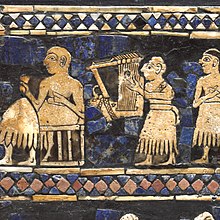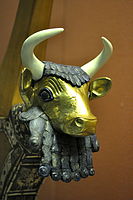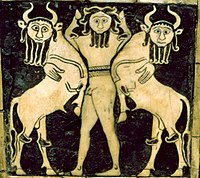Ur was an important Sumerian city-state in ancient Mesopotamia, located at the site of modern Tell el-Muqayyar in south Iraq's Dhi Qar Governorate. Although Ur was once a coastal city near the mouth of the Euphrates on the Persian Gulf, the coastline has shifted and the city is now well inland, on the south bank of the Euphrates, 16 km (10 mi) from Nasiriyah in modern-day Iraq. The city dates from the Ubaid period circa 3800 BC, and is recorded in written history as a city-state from the 26th century BC, its first recorded king being King Tuttues.

Lapis lazuli, or lapis for short, is a deep-blue metamorphic rock used as a semi-precious stone that has been prized since antiquity for its intense color. Originating from the Persian word for the gem, lāžward, lapis lazuli is a rock composed primarily of the minerals lazurite, pyrite and calcite. As early as the 7th millennium BC, lapis lazuli was mined in the Sar-i Sang mines, in Shortugai, and in other mines in Badakhshan province in modern northeast Afghanistan. Lapis lazuli artifacts, dated to 7570 BC, have been found at Bhirrana, which is the oldest site of Indus Valley civilisation. Lapis was highly valued by the Indus Valley Civilisation. Lapis beads have been found at Neolithic burials in Mehrgarh, the Caucasus, and as far away as Mauritania. It was used in the funeral mask of Tutankhamun.

Sumer is the earliest known civilization, located in the historical region of southern Mesopotamia, emerging during the Chalcolithic and early Bronze Ages between the sixth and fifth millennium BC. Like nearby Elam, it is one of the cradles of civilization, along with Egypt, the Indus Valley, the Erligang culture of the Yellow River valley, Caral-Supe, and Mesoamerica. Living along the valleys of the Tigris and Euphrates rivers, Sumerian farmers grew an abundance of grain and other crops, a surplus which enabled them to form urban settlements. The world's earliest known texts come from the Sumerian cities of Uruk and Jemdet Nasr, and date to between c. 3350 – c. 2500 BC, following a period of proto-writing c. 4000 – c. 2500 BC.

The music of Iraq or Iraqi music,, also known as the music of Mesopotamia, encompasses the music of a number of ethnic groups and musical genres. Ethnically, it includes Mesopotamian Arabic, Assyrian, Kurdish and the music of Turkmen, among others. Apart from the traditional music of these peoples, Iraqi music includes contemporary music styles such as pop, rock, soul and urban contemporary.

Puabi, also called Shubad or Shudi-Ad due to a misinterpretation by Sir Charles Leonard Woolley, was an important woman in the Sumerian city of Ur, during the First Dynasty of Ur. Commonly labeled as a "queen", her status is somewhat in dispute, although several cylinder seals in her tomb, labeled grave PG 800 at the Royal Cemetery at Ur, identify her by the title "nin" or "eresh", a Sumerian word denoting a queen or a priestess. Puabi's seal does not place her in relation to any king or husband, possibly indicating that she ruled in her own right. It has been suggested that she was the second wife of king Meskalamdug. Although little is known about Puabi's life, the discovery of Puabi's tomb and its death pit reveals important information as well as raises questions about Mesopotamian society and culture.

Ancient art refers to the many types of art produced by the advanced cultures of ancient societies with different forms of writing, such as those of ancient China, India, Mesopotamia, Persia, Palestine, Egypt, Greece, and Rome. The art of pre-literate societies is normally referred to as prehistoric art and is not covered here. Although some pre-Columbian cultures developed writing during the centuries before the arrival of Europeans, on grounds of dating these are covered at pre-Columbian art and articles such as Maya art, Aztec art, and Olmec art.

The First Dynasty of Ur was a 26th-25th century BCE dynasty of rulers of the city of Ur in ancient Sumer. It is part of the Early Dynastic period III of the history of Mesopotamia. It was preceded by the earlier First Dynasty of Kish and the First Dynasty of Uruk.

Music was ubiquitous throughout Mesopotamian history, playing important roles in both religious and secular contexts. Mesopotamia is of particular interest to scholars because evidence from the region—which includes artifacts, artistic depictions, and written records—places it among the earliest well-documented cultures in the history of music. The discovery of a bone wind instrument dating to the 5th millennium BCE provides the earliest evidence of music culture in Mesopotamia; depictions of music and musicians appear in the 4th millennium BCE; and later, in the city of Uruk, the pictograms for ‘harp’ and ‘musician’ are present among the earliest known examples of writing.
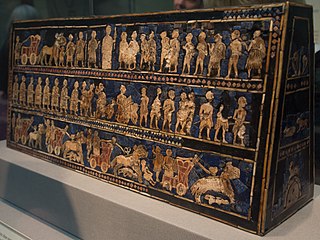
The Standard of Ur is a Sumerian artifact of the 3rd millennium BC that is now in the collection of the British Museum. It comprises a hollow wooden box measuring 21.59 centimetres (8.50 in) wide by 49.53 centimetres (19.50 in) long, inlaid with a mosaic of shell, red limestone and lapis lazuli. It comes from the ancient city of Ur. It dates to the First Dynasty of Ur during the Early Dynastic period and is around 4,600 years old. The standard was probably constructed in the form of a hollow wooden box with scenes of war and peace represented on each side through elaborately inlaid mosaics. Although interpreted as a standard by its discoverer, its original purpose remains enigmatic. It was found in a royal tomb in Ur in the 1920s next to the skeleton of a ritually sacrificed man who may have been its bearer.

Meskalamdug was an early Sumerian ruler of the First Dynasty of Ur in the 26th century BCE. He does not appear in the Sumerian King List, but is known from a royal cylinder seal found in the Royal Cemetery at Ur, a royal bead inscription found in Mari, both mentioning him as King, and possibly his tomb, grave PG 755 at the Royal Cemetery at Ur.

Sir Charles Leonard Woolley was a British archaeologist best known for his excavations at Ur in Mesopotamia. He is recognized as one of the first "modern" archaeologists who excavated in a methodical way, keeping careful records, and using them to reconstruct ancient life and history. Woolley was knighted in 1935 for his contributions to the discipline of archaeology. He married the British archaeologist Katharine Woolley.

The Early Dynastic period is an archaeological culture in Mesopotamia that is generally dated to c. 2900 – c. 2350 BC and was preceded by the Uruk and Jemdet Nasr periods. It saw the development of writing and the formation of the first cities and states. The ED itself was characterized by the existence of multiple city-states: small states with a relatively simple structure that developed and solidified over time. This development ultimately led to the unification of much of Mesopotamia under the rule of Sargon, the first monarch of the Akkadian Empire. Despite this political fragmentation, the ED city-states shared a relatively homogeneous material culture. Sumerian cities such as Uruk, Ur, Lagash, Umma, and Nippur located in Lower Mesopotamia were very powerful and influential. To the north and west stretched states centered on cities such as Kish, Mari, Nagar, and Ebla.

The Department of the Middle East, numbering some 330,000 works, forms a significant part of the collections of the British Museum, and the world's largest collection of Mesopotamian antiquities outside Iraq. The collections represent the civilisations of the ancient Near East and its adjacent areas.
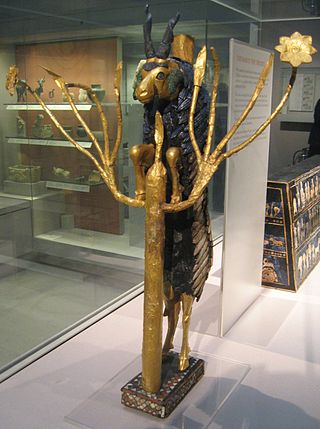
The Ram in a Thicket is a pair of figures excavated at Ur, in southern Iraq, which date from about 2600–2400 BC. One is in the Mesopotamia Gallery in Room 56 of the British Museum in London; the other is in the University of Pennsylvania Museum in Philadelphia, USA.
Imports to Ur reflect the cultural and trade connections of the Sumerian city of Ur. During the period of the Early Dynastic III royal cemetery, Ur was importing elite goods from geographically distant places. These objects include precious metals such as gold and silver, and semi-precious stones, namely lapis lazuli and carnelian. These objects are all the more impressive considering the distance from which they traveled to reach Mesopotamia and Ur specifically.

The art of Mesopotamia has survived in the record from early hunter-gatherer societies on to the Bronze Age cultures of the Sumerian, Akkadian, Babylonian and Assyrian empires. These empires were later replaced in the Iron Age by the Neo-Assyrian and Neo-Babylonian empires. Widely considered to be the cradle of civilization, Mesopotamia brought significant cultural developments, including the oldest examples of writing.

The Royal Cemetery at Ur is an archaeological site in modern-day Dhi Qar Governorate in southern Iraq. The initial excavations at Ur took place between 1922 and 1934 under the direction of Leonard Woolley in association with the British Museum and the University of Pennsylvania Museum of Archaeology and Anthropology in Philadelphia, Pennsylvania, United States.

The Bull Headed Lyre is one of the oldest string instruments ever discovered. The lyre was excavated in the Royal Cemetery at Ur during the 1926–1927 season of an archeological dig carried out in what is now Iraq jointly by the University of Pennsylvania and the British Museum. Leonard Woolley led the excavations.

Akalamdug was an early ruler of the First Dynasty of Ur in the 26th century BCE. He does not appear in the Sumerian King List, but is known from his tomb and an inscription at the Royal Cemetery at Ur. He may have been the father of Meskalamdug, as suggested by the similarity of their names and the chronological proximity of their graves. Alternatively, he may have been the son of Meskalamdug, and therefore brother of the great ruler Mesannepada.

Queen Puabi's headdress is a 2600-2450 BCE Mesopotamian crown consisting of ornate gold leaf wreaths, strands of lapis lazuli and carnelian beads, with a gold comb, and delicate hair ribbons. The entirety of the headdress is estimated to weigh over 6 pounds. The headdress was discovered resting on Queen Puabi's remains in PG 800 during the excavation of the Royal Cemetery at Ur that began in 1922 and concluded in 1934. Successive Mesopotamian societies built new cities on top of previous civilizations and commonly created tells to preserve human remains. These younger tells hid and protected her immense riches by making them inaccessible to looters. Found next to Queen Puabi's remains was a cylinder (identification) seal with the title "nin" inscribed, indicating a great lady or queen. In the grave, excavators also found the remnants of female attendants –– adorned in similar jewelry and hair ribbons –– whose purpose was to serve the queen in her afterlife. The religious significance of Queen Puabi's headdress demonstrates her royal status as well as her cultic importance. The unearthing of Ur was led by Charles Leonard Woolley and was a joint expedition sponsored by the Penn Museum and the British Museum. The headdress currently resides in the Penn Museum in Philadelphia. The excavation is still very popular because of the riches discovered, the uncovering of a mass grave, and the potential connection with Abraham from the book of Genesis.


